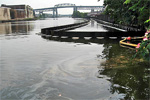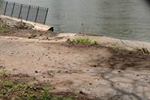June 2014 Update
Dear Friend,
The past few months in Congress have been incredibly busy. The House passed my bills to crack down on human trafficking, provide grants for rape kit DNA analysis and establish a Congressional Commission on creating a National Women's History Museum.
I am now working to pass bills to extend the Terrorism Risk Insurance Program, lift the gag order on gun violence research, and help stop Fannie Mae and Freddie Mac from making investments that reduce the availability of affordable housing in places like Stuyvesant Town/Peter Cooper Village.
I'm a strong supporter of infrastructure projects that expand our mass transit system, improve our resiliency or expand open space such as the Second Avenue Subway, East Side Access, Queens Seawall, the East River Esplanade, storm surge barriers for Newtown Creek, and other Sandy recovery efforts. And I’m continuing the fight against the East 91st Street Marine Transfer Station, which will add traffic, pollution and other problems to the community.
Read about this important work below, and don't hesitate to call or email my office if you need more information.
Best regards,

House passes National Women’s History Museum bill

On May 7th, the House of Representatives passed the legislation I introduced with Rep. Marsha Blackburn to study the creation of a National Women’s History Museum in Washington, DC. The bipartisan legislation passed by a vote of 383 to 33 and now heads to the Senate, where Senators Susan Collins (R-ME) and Barbara Mikulski (D-MD) are leading the charge. Read the story from the Associated Press and listen to my interview on NPR’s Here & Now about this historic achievement.
House votes to extend Debbie Smith DNA Grant program

On April 7th, the House voted to extend the Debbie Smith Act, legislation I authored to fund DNA analysis of untested rape kits. Sexual assault survivors and advocates Debbie Smith and Natasha Alexenko were present in the house gallery for the vote. The Debbie Smith Act has been called the most important anti-rape legislation ever signed into law. I first introduced the bill in 2001 and it passed as part of the Justice for All Act in 2004. Read the story in the New York Daily Newsand watch the clip from New York 1.
House passes anti-human trafficking bills

On May 20th, the House of Representatives passed the Justice for Victims of Trafficking Act. I was the lead Democratic co-sponsor of the bill introduced by Congressman Ted Poe – a Republican from Texas. The bill will help law enforcement prosecute human traffickers, rescue victims, and help survivors rebuild their lives. I was also proud to introduce a new bill with Congressman Poe - the Human Trafficking Fraud Enforcement Act - to create a new department within the IRS charged with prosecuting sex traffickers for violations of tax law. Read the story in the New York Daily News.
New bill to fund gun violence research
I’ve introduced new legislation with Senator Ed Markey (D-MA) to fund research at the Centers for Disease Control and Prevention (CDC) on gun violence prevention and firearms safety. The legislation calls for $10 million each year for six years beginning in 2015. President Obama included $10 million in his budget proposal released in March after lifting the 17-year ban on federal gun violence research in 2013. Since the mid-1990s, federal funding for gun violence research has almost halted entirely in response to pressure from the pro-gun lobby. Read my op-ed and check out the story from Pro Publica.
Time to reauthorize Terrorism Risk Insurance Act

One of the most important actions Congress took after 9/11 was to pass the Terrorism Risk Insurance Act (TRIA). TRIA has provided affordable insurance against a terrorist attack for over a decade at no cost to taxpayers. Without TRIA, development in New York City and around the country would grind to a halt, but the program is set to expire this year unless Congress takes action. I’ve co-authored a bill to extend the program but the longer we wait to act, the more prices will increase and the less available insurance will become. New York’s economy will be badly hurt unless we act soon. New York 1 has the story.
New bill to prevent investments that undermine affordable housing

Last week I introduced new legislation to sharply curtail the ability of Fannie Mae and Freddie Mac to make investments that reduce the availability of affordable housing. This bill would help prevent a recurrence of what happened at Stuyvesant Town/Peter Cooper Village. Fannie Mae and Freddie Mac earned “affordable housing goals credits” by investing in the Stuyvesant Town deal – despite the fact that the transaction reduced the supply of affordable housing. Read more about the Responsible GSE Affordable Housing Investment Act of 2014.
Progress on the 2nd Avenue Subway

The MTA is hitting its milestones and Phase 1 of the Second Avenue Subway project is 960 days from completion. The MTA has all of the federal and state funding needed to build the project, the designing is complete, tunneling is finished, and blasting operations have concluded. All of the contracts have been bid and executed, and work is underway at each of the stations, subway entrances and ancillary buildings. While there remains a lot of work to be done – installation of tracks, completion of stations, entrances and ancillary buildings – this project is on track to be finished by December 2016 - its scheduled completion date. Read more about the project’s progress and check out the story in the Daily News.
Funding secured to repair East River Esplanade

I formed the East River Esplanade Task Force in 2010 to encourage improvements to the ailing waterfront trail. This year, Councilmember Ben Kallos and I wrote a joint letter to Mayor de Blasio urging him to make the esplanade a priority and continue the department’s working relationship with the task force. The Mayor responded by including $35 million in this year’s budget – a great start! The total cost of the repairs would be $115 million over 10 years. Click here to learn more.
Effort to build storm surge barriers for Newtown Creek

Since Newtown Creek was declared a Superfund Site in 2012, the Environmental Protection Agency has been engaged in a two phase remedial investigation of the extent of the pollution. Phase 1 was completed in March 2013 and Phase 2 began in the Spring of 2014. This spring, the New York State Department of Health released a Public Health Assessment, which was prepared under a cooperative agreement with the US Department of Health and Human Services. The report concluded that swimming and other full body immersion recreation such as scuba diving in Newtown Creek could harm people’s health, as could eating fish and crabs taken from the Creek. Click here to read the Public Health Assessment.
During Superstorm Sandy, Newtown Creek flooded, sending polluted water cascading into businesses and homes. Last week, the New York City Economic Development Corporation (NYCEDC) issued a Request for Proposals seeking a consultant or consultant team to conduct a study that would suggest options for storm surge barriers to prevent flooding from Newtown Creek. This project will be funded through the federal Community-Development Block Grant-Disaster Recovery program and will be subject to approval by the US Army Corps of Engineers. Click here for more information about the RFP.
Opposing a waste transfer station at 91st Street

I am continuing my work to stop a massive waste transfer station at 91st Street along the East River, which would have a disastrous impact on this dense residential neighborhood and greatly increase public cost for collection and disposal of trash. The Upper East Side has some of the poorest air quality in New York City, and the MTS will surely make it worse. In addition, the site is in a special flood hazard area, which means that it is likely to flood during a significant storm like Sandy. In May, I joined community activists and local elected officials to protest the removal of 30-year-old pear trees along Asphalt Green’s playing fields. The trees provided much-needed shade to children using the fields and will be sorely missed during the hot summer months. I am also working with the City, elected officials and community leaders to explore other ways to reduce the impact of Manhattan’s garbage on other boroughs and find modern garbage disposal solutions that will make the city greener and more sustainable. You can read coverage of the rally by clicking here. I also joined local elected officials in a letter that called attention to the huge rise in the cost of the project from $44 million in 2002 to $215 million in the FY2015 budget. The Daily News has the story on the letter here.
Repairing Queens Seawall

At long last, residents of Western Queens will be able to enjoy access to a portion of the East River waterfront that was off-limits for years. Well over a decade ago, a 200 foot portion of the Queens seawall on the East River in Queensbridge Park near Queensbridge Houses failed, and experts warned of further deterioration unless repairs were made. In 2004, I created a task force which brought the elected officials, and city and state agencies to work on the project. I was able to secure more than $400,000 in funding for the project from the federal government. Unfortunately, progress stalled for a number of years while the City looked for additional funding sources. I later revived the task force along with the Borough President, and Councilman Jimmy Van Bramer, and the City Council. The Administration ended up providing millions in City funding, while the Metropolitan Transportation Authority also provided state funding.
The finished project will feature new paving, landscaping and benches, as well as a 6-foot wide waterfront promenade, and a small wharf at its northern end. The project is nearing completion with a ribbon cutting expected next week. The New York City Department of Parks and Recreation has more details on the project.
Working to prevent another storm surge

I recently joined U.S. Department of Housing and Urban Development (HUD) Secretary Shaun Donovan for an announcement that the federal government has awarded $335 million to build a 19-ft high berm stretching 1.5 miles along the FDR Drive on the Lower East Side from Montgomery Street to 23rd Street. Known as the “Bridging Berm,” the project will effectively raise the riverbank to nine feet above current level, which is more than four feet above Superstorm Sandy’s high-water mark. The plan is Phase 1 of a larger proposal by The Bjarke Ingels Group, aka BIG Team, called the “Big U” resiliency plan, which includes additional plans for roll-down storm gates hanging from the FDR to protect Chinatown, a berm along the Battery to protect the Financial District and more. The Bridging Berm was the biggest winner of the “Rebuild by Design” contest sponsored by HUD and the Rockefeller Foundation. The Berm is designed to not only shield the city against floods and storm water, but also provide an improved public space for community members and visitors.
The Berm will include a barrier along the East River on the Lower East Side, protecting more than 50,000 residents, as well as the Con Edison Plant at 14th Street where storm flooding caused a transformer explosion that resulted in a massive blackout below 39th street. It will also double the number of pedestrian bridges across the FDR, widen the bridges, and make the park more inviting and accessible. Read coverage of the announcement here and take a look at the project here.


